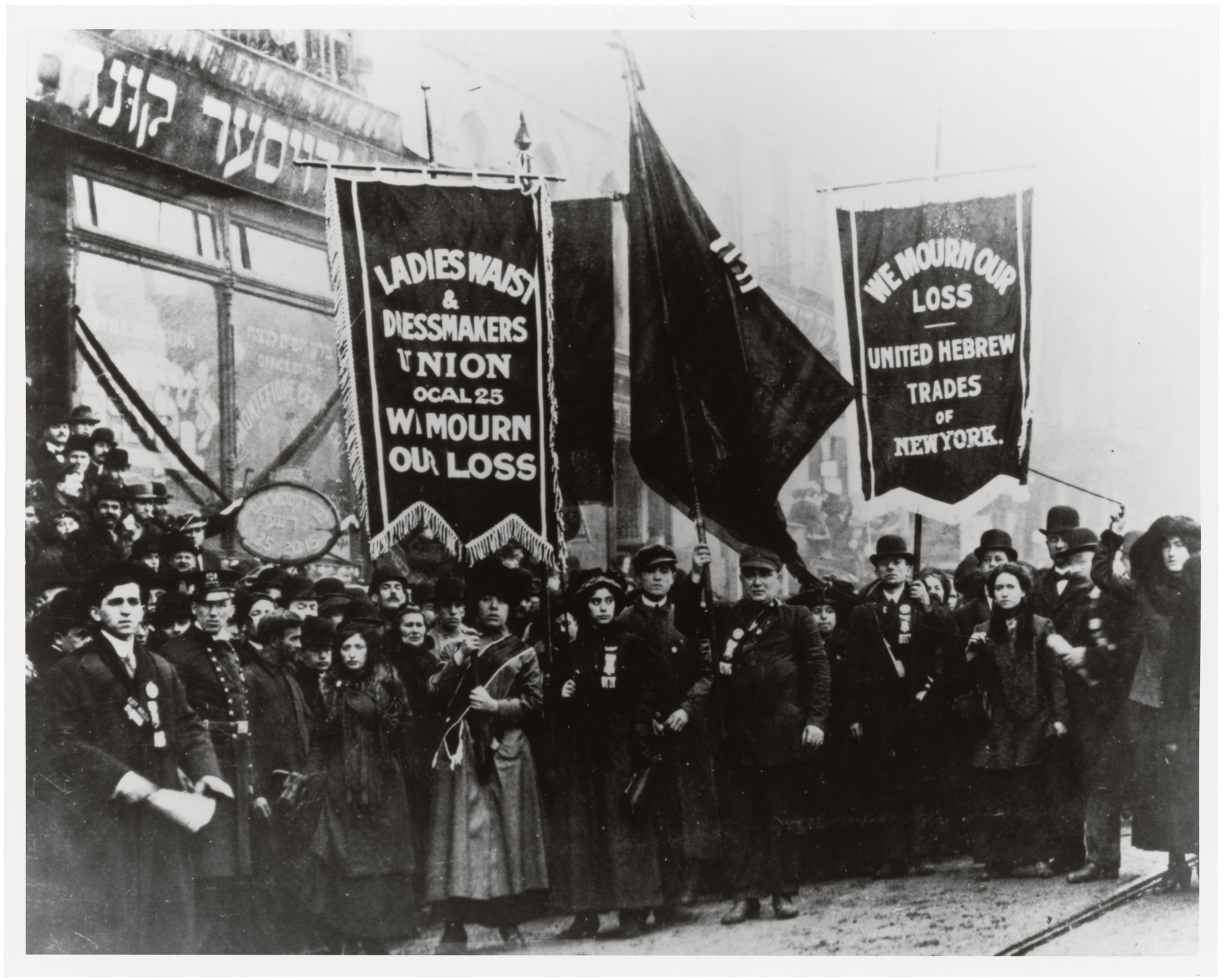The Triangle Shirtwaist fire took place on March 25, 1911. It was a terrible tragedy — 146 people died, most of them Jewish immigrant women — and the deadliest industrial disaster in New York City’s history.
Suddenly, in 2019, it seems like everyone is talking about the Triangle Shirtwaist Fire and Frances Perkins, an activist who witnessed the fire and later played a large role in reforming workers’ rights and protections. Why? Mainly because of 2020 Democratic candidate Elizabeth Warren, who cited the fire in a recent speech she made at a rally in New York City.
“We’re not here because of men,” Warren said to the crowd in Washington Square Park on September 16. “We’re here because of some hardworking women. Women who, more than a hundred years ago, worked long hours in a brown 10-story building just a block that way. Women who worked at the Triangle Shirtwaist Factory.”
So what exactly happened, and why is Warren talking about it now? Let’s break it down.
First, what was happening in NYC at the time?
So glad you asked! The Triangle Shirtwaist Fire needs to be put into context of the labor movements of the time. Mainly, the New York shirtwaist strike of 1909. This strike — also known as the Uprising of the 20,000 — was a strike mainly by Jewish women in NYC.
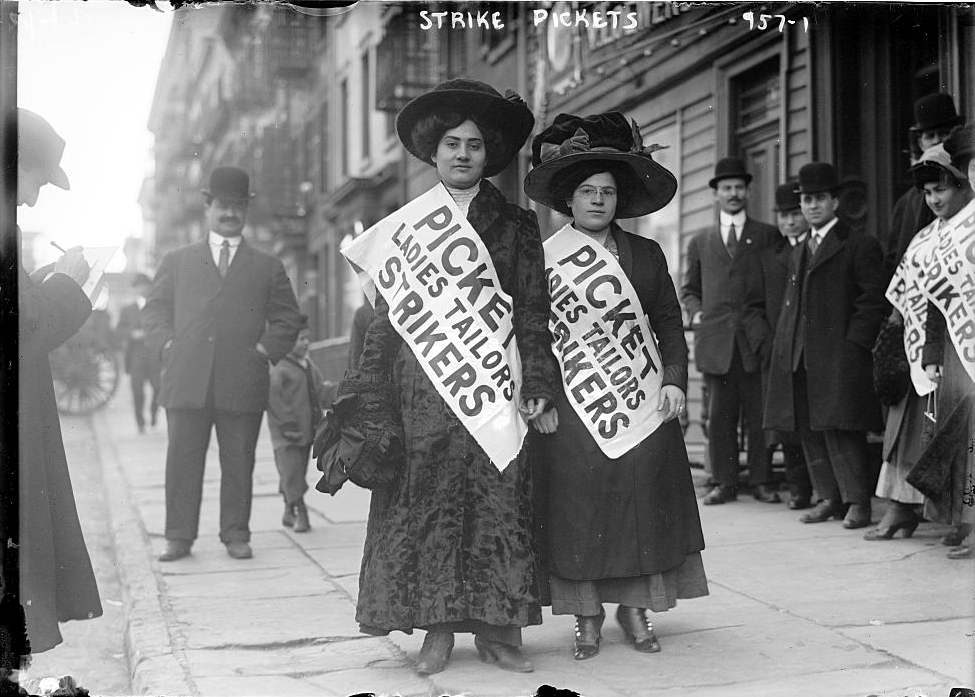 Uprising of the 20,000
Uprising of the 20,000
On November 22, 1909, at a massive workers meeting held at Cooper Union, Clara Lemlich declared in Yiddish, “I am tired of listening to speakers who talk in general terms… I move that we go on a general strike!” Clara, born in the Ukraine and raised on the Lower East Side, was a young woman who became a leader in the labor movement.
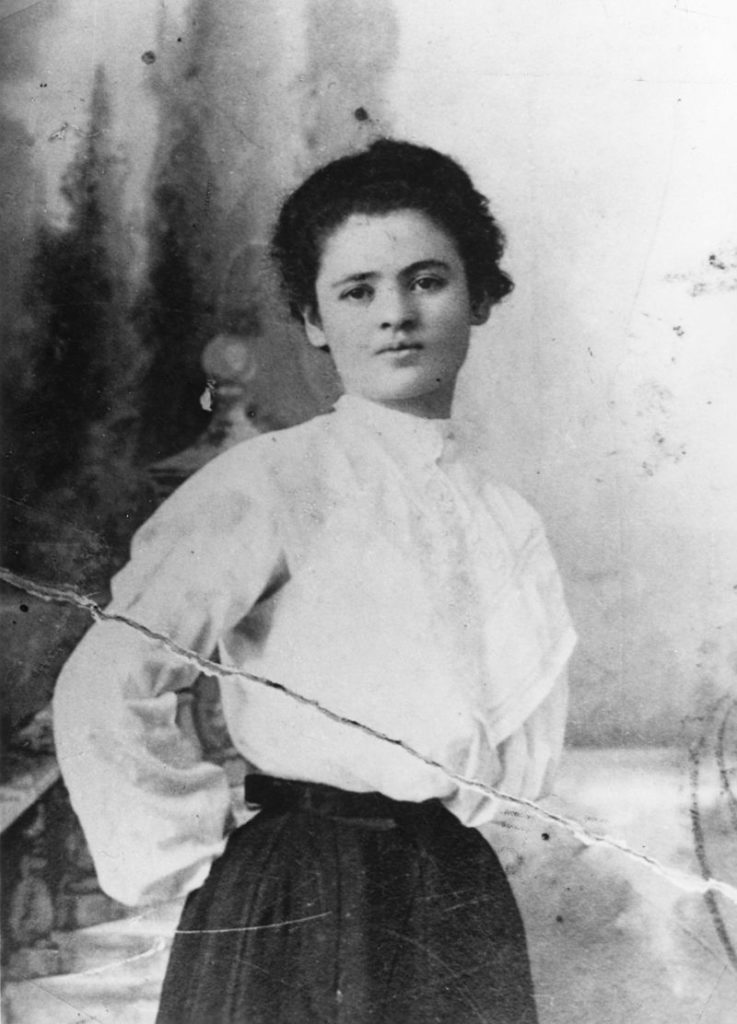
Thousands of young Jewish women heeded Clara’s call and went on strike. The strike halted in February 1910; many small and medium-sized factories agreed to a 52-hour work week. And, they recognized their union: the International Ladies’ Garment Workers’ Union. Yet, many workers went back to work without these agreements.
What does this have to do with the Triangle Shirtwaist Fire?
Many larger factories were not swayed by the Uprising of the 20,000, including the Triangle Shirtwaist Factory and the Leiserson Company.
As Jewish Women’s Archive writes, “From the outset, the young strikers faced three-way opposition from the manufacturers, the police, and the courts. Triangle and Leiserson hired thugs and prostitutes to abuse strikers, often with aid from policemen who then arrested strikers on trumped-up charges of assault. In court, strikers faced hostile magistrates who upbraided the young women (‘You are striking against God and nature,’ scolded one enraged judge), fined them, and, in some cases, sentenced them to the workhouse.”
As the New York Times points out regarding the Uprising, “One holdout was the Triangle Shirtwaist Factory, where an infamous fire killed 146 workers a year later. The male union negotiators had ignored the striking women’s safety concerns, letting factories off the hook for conditions inside.”
Oy. Okay. We see where this is going.
Yeah…
So, what happened at the Triangle Shirtwaist Fire?
Saturday, March 25, 1911, around 800 young women (and a couple dozen young men) were working on the top floors of the Triangle Shirtwaist Company building. (The building was located at 23-29 Washington Place.) Someone tossed a cigarette into waste materials, and the building became engulfed in flames. It was practice in these sweatshops, like the Triangle Shirtwaist Building, to lock the doors outside the workroom — to prevent breaks. There was no escape for the workers trapped inside.
In an eyewitness testimony, Louis Waldman explains the scene: “Horrified and helpless, the crowds — I among them — looked up at the burning building, saw girl after girl appear at the reddened windows, pause for a terrified moment, and then leap to the pavement below, to land as mangled, bloody pulp. This went on for what seemed a ghastly eternity. Occasionally a girl who had hesitated too long was licked by pursuing flames and, screaming with clothing and hair ablaze, plunged like a living torch to the street. Life nets held by the firemen were torn by the impact of the falling bodies.”
Rose Cohen, who survived the tragedy, said, “I couldn’t stop crying for hours, for days. Afterwards, I used to dream I was falling from a window, screaming. I remember I would holler to my mother in the dark, waking everybody up, ‘Mama! I just jumped out of a window!’ Then I would start crying and I couldn’t stop.”
Many jumped to their deaths, rather than stay inside the burning building. In total, 146 people died.
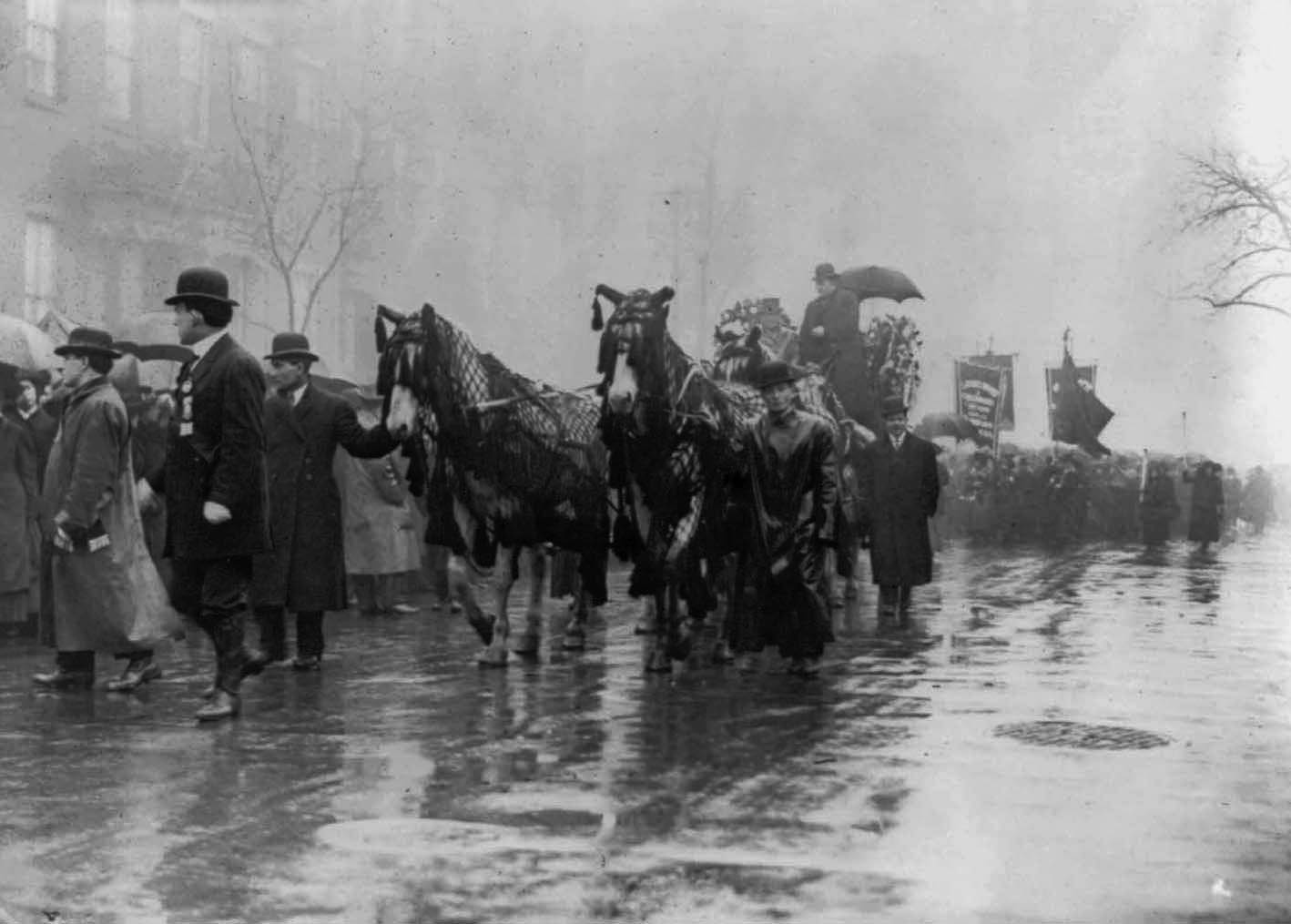 People and horses draped in black walk in procession in memory of the victims of the Triangle Shirtwaist Company fire, New York City. (Image via Library of Congress)
People and horses draped in black walk in procession in memory of the victims of the Triangle Shirtwaist Company fire, New York City. (Image via Library of Congress)
As the tragedy primarily impacted the Jewish community, many came together to mourn.
Here’s the Mournful Song of the Great Fire, by Yehuda Horvitz:
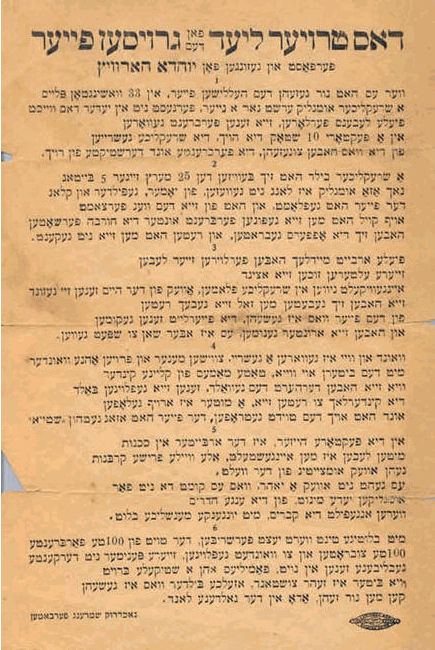
(Read an English translation here.)
Were there consequences?
The factory’s owners, Max Blanck and Isaac Harris, survived the fire. They were indicted in December 1911, but a jury acquitted them of first- and second-degree manslaughter. (You can read the full text of the trial here.)
In 1913, Blanck and Harris were sued in a wrongful death suit, and plaintiffs won $75 for each victim. The same year, Blanck was arrested for locking his factory doors. He was fined $20.
That’s depressing.
Yeah.
Were there any positive consequences?
Yes! People were outraged. As Hadassa Kosak writes in the Jewish Women’s Archive, “To the Jewish community, the unprecedented scope of the tragedy and its horrors were evocative of the pogroms that were the greatest disaster to befall Jewry in modern times… The outrage and the grief galvanized the Jewish community and the progressive public into action.”
Notably, Rose Schneiderman, a Jewish woman who led the strike at the Triangle factory, took the lead. (She had helped organize with Clara.) Schneiderman gave a speech on April 2, 1911, where she said:
“I would be a traitor to these poor burned bodies if I came here to talk good fellowship. We have tried you good people of the public and we have found you wanting.
The old Inquisition had its rack and its thumbscrews and its instruments of torture with iron teeth. We know what these things are today; the iron teeth are our necessities, the thumbscrews are the high-powered and swift machinery close to which we must work, and the rack is here in the firetrap structures that will destroy us the minute they catch on fire.
This is not the first time girls have been burned alive in the city. Every week I must learn of the untimely death of one of my sister workers. Every year thousands of us are maimed. The life of men and women is so cheap and property is so sacred. There are so many of us for one job it matters little if 146 of us are burned to death.”
She ended her speech with a call on working people: “I can’t talk fellowship to you who are gathered here. Too much blood has been spilled. I know from my experience it is up to the working people to save themselves. The only way they can save themselves is by a strong working-class movement.”
So what happened?
Frances Perkins, an activist, witnessed the Shirtwaist Factory Fire. She had seen Rose speak, later recounting, “I’ll never forget this was the first time I ever had heard Rose Schneiderman speak… She was an unknown little girl, a little red headed girl; she couldn’t have been, well, she couldn’t have come up to my shoulder. Very small type but with red hair, fiery red hair, and blazing eyes and pretty too… She made a remarkable speech which really stirred people.”
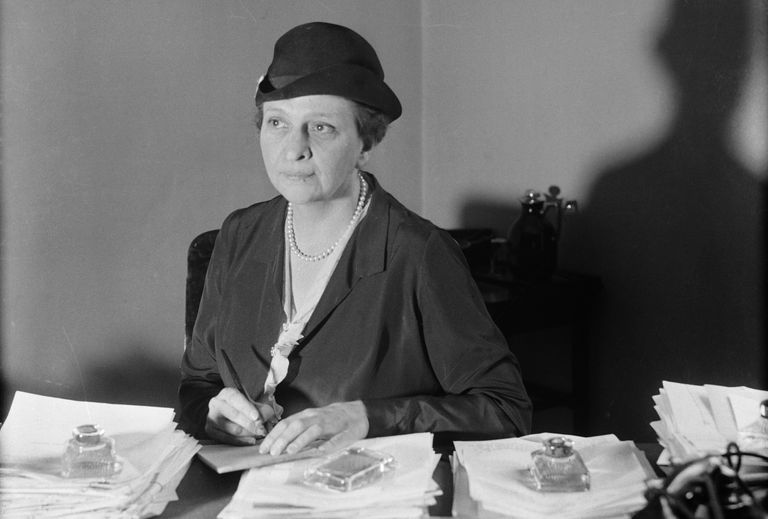
Frances Perkins was then appointed executive secretary to the newly-formed Committee on Public Safety by Theodore Roosevelt. As the Frances Perkins Center writes, “One of the Committee’s first actions was to seek a state commission to investigate and make legislative recommendations. The Factory Investigating Commission’s mandate was much broader than originally contemplated: to study not only fire safety, but other threats to the health and well-being of industrial workers and the impact of those threats upon families. Frances Perkins, by that time a recognized expert in the field of worker health and safety, served as expert witness, investigator and guide, leading legislators on inspections of the state’s factories and worksites to view first-hand the dangers of unfettered industrialism. The Commission’s work resulted in the most comprehensive set of laws governing workplace health and safety in the nation.”
Perkins would go on to serve as Franklin Delano Roosevelt’s labor secretary, becoming the first woman to serve as a cabinet secretary.
As Cornell’s project on the Shirtwaist Fire points out, the fire “is widely considered a pivotal moment in history, leading to the transformation of the labor code of New York State and to the adoption of fire safety measures that served as a model for the whole country.” There were 36 new labor bills adopted by New York as a result.
Alright! So why is it relevant in 2019?
As we mentioned in the introduction, we’re mainly talking about this again because of Elizabeth Warren. She began her speech in Washington Square Park, in NYC, by discussing the Triangle Shirtwaist Factory Fire.
“Tonight it is a little something different,” Warren began. “I want to tell you a story I haven’t had the chance to tell before. It is an important story about our past and about our future… I am especially glad to be here in Washington Square Park. I wanted to give this speech right here, and not because of the arch behind me or the president that this square is named for. We are not here today because of famous arches or famous men. In fact we are not here because of men at all. We are here because of some hard-working women, women who more than 100 years ago worked long hours in a 10-story building a block that way. Women who worked at the Triangle Shirtwaist Factory.”
Then she gets into the story, and we think including the whole transcript is important:
Here is what I want you to hear. It was March 25, 1911, a Saturday. At 4:45 in the afternoon, people walking through this park looked up and saw black smoke billowing into the sky. A fire had started in that building. And inside that building on the top three floors, deadly flames leapt from a bin to the oily floors,
Fighting for their lives, women — girls, really, some as young as 14 — raced to escape, but the exit doors were locked. Others ran to the windows, waving their arms and screaming for help. No help was coming. The fire department’s ladders could only reach to the sixth floor. The flames leapt higher and women started crawling out onto the ledges. And as people on the ground stood in shock silence, a woman jumped. And then another and then another. They hit the ground with a sickening thud. They died on impact. So many, so fast, that women’s bodies piled up on the sidewalk, their blood ran into the gutters.
Dozens more were trapped inside, because the door to the staircase was locked — locked by bosses who were afraid the workers might steal scraps of cloth. Firefighters would later find a pile of burned bodies next to that locked door. It took 18 minutes for 146 people to die. Mostly women, mostly immigrants, Jewish and Italian, mostly people who made as little as five dollars a week to get their shot at the American Dream.
It was one of the worst industrial disasters in American history, one of the worst, but it should not have been a surprise. For years across the city, women factory workers and their allies had been sounding the alarm about dangerous and squalid conditions, fighting for shorter hours and higher pay. They protested, they went on strike, they got coverage in the press. Everyone knew about these problems. But the fat profits were making New York’s factory owners rich, and they had no plans to give that up. Instead of changing conditions at the factories, the owners worked their political connections. They made campaign contributions and talked with their friends in the legislature. They greased the state government so thoroughly that nothing changed. Business owners got richer, politicians got more powerful, and working people paid the price. Does any of this sound familiar?
Wow, Elizabeth Warren.
Yeah. She also went on to talk specifically about Frances Perkins and how she became the first woman to serve in the cabinet, as well as the “structural change” she pushed for once she was there. She emphasized how women were sounding the alarm before the fire (i.e. Uprising of 20,000, even though she didn’t mention it by name), and how women led the reform movements.
What was the reaction to her speech?
One onlooker tweeted “thousands of people are standing in rapt silence as she talks” about the fire. Her focus on this resonated with many:
https://twitter.com/HurricaneZara/status/1173755951213621248?s=20
.@ewarren is telling the story of the Triangle Shirtwaist Fire like she knew & loved the women inside. Saw their struggle & their courage. And will fight like hell with & for them. pic.twitter.com/V0t3gHpwgR
— Brad Lander (@bradlander) September 16, 2019
Learning about the Triangle Shirtwaist Factory fire that killed 146 workers was a key part of developing my own political identity. So I just loved how @ewarren connected that history to current movements for social change. We are making history everyday https://t.co/mgLEpyH7NH
— Udi Ofer (@udiofer_) September 18, 2019
I can’t even go near my emotions re. @ewarren opening her speech tonight talking in detail about the Triangle Shirtwaist Factory fire.
— Continuity Ted Leo Account (@tedleo) September 17, 2019
https://twitter.com/rachsyme/status/1173948271284445186
Our takeaway?
The history of the Jewish women who died, and the Jewish woman (and other allies like Frances Perkins!) who organized, should be remembered. Not just by presidential candidates — by everyone.
Header Image: Demonstrators mourn for the deaths of victims of the Triangle Shirtwaist Factory fire, New York, New York, 1911. (Photo by PhotoQuest/Getty Images)
